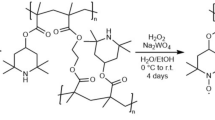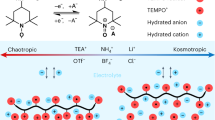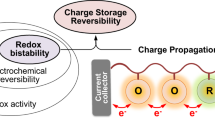Abstract
Organic radical polymers for batteries represent some of the fastest-charging redox active materials available. Electron transport and charge storage must be accompanied by ion transport and doping for charge neutrality, but the nature of this process in organic radical polymers is not well understood. This is difficult to intuitively predict because the pendant radical group distinguishes organic radical polymers from conjugated, charged or polar polymers. Here we show for the first time a quantitative view of in situ ion transport and doping in organic radical polymers during the redox process. Two modes dominate: doping by lithium ion expulsion and doping by anion uptake. The dominance of one mode over the other is controlled by anion type, electrolyte concentration and timescale. These results apply in any scenario in which electrolyte is in contact with a non-conjugated redox active polymer and present a means of quantifying doping effects.
This is a preview of subscription content, access via your institution
Access options
Access Nature and 54 other Nature Portfolio journals
Get Nature+, our best-value online-access subscription
$29.99 / 30 days
cancel any time
Subscribe to this journal
Receive 12 print issues and online access
$259.00 per year
only $21.58 per issue
Buy this article
- Purchase on Springer Link
- Instant access to full article PDF
Prices may be subject to local taxes which are calculated during checkout





Similar content being viewed by others
Data availability
The datasets collected and analysed in the current study are included in the Supplementary Information and/or are available from the corresponding author upon request.
References
Song, Z. & Zhou, H. Towards sustainable and versatile energy storage devices: an overview of organic electrode materials. Energy Environ. Sci. 6, 2280–2301 (2013).
Janoschka, T., Teichler, A., Krieg, A., Hager, M. D. & Schubert, U. S. Polymerization of free secondary amine bearing monomers by RAFT polymerization and other controlled radical techniques. J. Polym. Sci. A 50, 1394–1407 (2012).
Suga, T., Pu, Y.-J., Kasatori, S. & Nishide, H. Cathode- and anode-active poly(nitroxylstyrene)s for rechargeable batteries: p- and n-type redox switching via substituent effects. Macromolecules 40, 3167–3173 (2007).
Nishide, H. & Suga, T. Organic radical battery. Electrochem. Soc. Interface 14, 32–36 (2005).
Suga, T., Pu, Y.-J., Oyaizu, K. & Nishide, H. Electron-transfer kinetics of nitroxide radicals as an electrode-active material. Bull. Chem. Soc. Jpn 77, 2203–2204 (2004).
Nevers, D. R., Brushett, F. R. & Wheeler, D. R. Engineering radical polymer electrodes for electrochemical energy storage. J. Power Sources 352, 226–244 (2017).
Tarascon, J. M. & Armand, M. Issues and challenges facing rechargeable lithium batteries. Nature 414, 359–367 (2001).
Arico, A. S., Bruce, P., Scrosati, B., Tarascon, J.-M. & Van Schalkwijk, W. Nanostructured materials for advanced energy conversion and storage devices. Nat. Mater. 4, 366–377 (2005).
Janoschka, T., Hager, M. D. & Schubert, U. S. Powering up the future: radical polymers for battery applications. Adv. Mater. 24, 6397–6409 (2012).
Nakahara, K. et al. Rechargeable batteries with organic radical cathodes. Chem. Phys. Lett. 359, 351–354 (2002).
Sato, K. et al. Diffusion-cooperative model for charge transport by redox-active nonconjugated polymers. J. Am. Chem. Soc. 140, 1049–1056 (2018).
Karlsson, C., Suga, T. & Nishide, H. Quantifying TEMPO redox polymer charge transport toward the organic radical battery. ACS Appl. Mater. Interf. 9, 10692–10698 (2017).
Oyaizu, K. & Nishide, H. Radical polymers for organic electronic devices: A radical departure from conjugated polymers? Adv. Mater. 21, 2339–2344 (2009).
Oyaizu, K., Ando, Y., Konishi, H. & Nishide, H. Nernstian adsorbate-like bulk layer of organic radical polymers for high-density charge storage purposes. J. Am. Chem. Soc. 130, 14459–14461 (2008).
Nakahara, K., Oyaizu, K. & Nishide, H. Electrolyte anion-assisted charge transportation in poly(oxoammonium cation/nitroxyl radical) redox gels. J. Mater. Chem. 22, 13669–13673 (2012).
Joo, Y., Agarkar, V., Sung, S. H., Savoie, B. M. & Boudouris, B. W. A nonconjugated radical polymer glass with high electrical conductivity. Science 359, 1391–1395 (2018).
Rostro, L., Wong, S. H. & Boudouris, B. W. Solid state electrical conductivity of radical polymers as a function of pendant group oxidation state. Macromolecules 47, 3713–3719 (2014).
Rostro, L., Baradwaj, A. G. & Boudouris, B. W. Controlled radical polymerization and quantification of solid state electrical conductivities of macromolecules bearing pendant stable radical groups. ACS Appl. Mater. Interf. 5, 9896–9901 (2013).
Zhang, Y. et al. Impact of the synthesis method on the solid-state charge transport of radical polymers. J. Mater. Chem. C 6, 111–118 (2017).
Kemper, T. W., Gennett, T. & Larsen, R. E. Molecular dynamics simulation study of solvent and state of charge effects on solid-phase structure and counterion binding in a nitroxide radical containing polymer energy storage material. J. Phys. Chem. C 120, 25639–25646 (2016).
Yang, Z., Dixon, M. C., Erck, R. A. & Trahey, L. Quantification of the mass and viscoelasticity of interfacial films on tin anodes using EQCM-D. ACS Appl. Mater. Interf. 7, 26585–26594 (2015).
Levi, M. D. et al. Electrochemical quartz crystal microbalance (EQCM) studies of ions and solvents insertion into highly porous activated carbons. J. Am. Chem. Soc. 132, 13220–13222 (2010).
Tsai, W.-Y., Taberna, P.-L. & Simon, P. Electrochemical quartz crystal microbalance (EQCM) study of ion dynamics in nanoporous carbons. J. Am. Chem. Soc. 136, 8722–8728 (2014).
Oyama, N. & Ohsaka, T. Coupling between electron and mass transfer kinetics in electroactive polymer films — An application of the in situ quartz crystal electrode. Prog. Polym. Sci. 20, 761–818 (1995).
Sano, N. et al. Polyviologen hydrogel with high-rate capability for anodes toward an aqueous electrolyte-type and organic-based rechargeable device. ACS Appl. Mater. Interf. 5, 1355–1361 (2013).
Daifuku, H. et al. Quartz crystal microbalance study on redox reaction mechanism of polyaniline. Synth. Met. 43, 2897–2900 (1991).
Mizunuma, M., Ohsaka, T., Miyamoto, H. & Oyama, N. Investigation of ion and solvent transport accompanying redox reactions of polyvinylferrocene films using an in situ electrochemical quartz crystal microbalance technique. Bull. Chem. Soc. Jpn 64, 2887–2893 (1991).
McCubbin, G. A. et al. QCM-D fingerprinting of membrane-active peptides. Eur. Biophys. J. 40, 437–446 (2011).
He, J. et al. A highly transparent crosslinkable radical copolymer thin film as the ion storage layer in organic electrochromic devices. ACS Appl. Mater. Interf. 10, 18956–18963 (2018).
Hauffman, G., Vlad, A., Janoschka, T., Schubert, U. & Gohy, J.-F. Nanostructured organic radical cathodes from self-assembled nitroxide-containing block copolymer thin films. J. Mater. Chem. A 3, 19575–19581 (2015).
Gagne, R. R., Koval, C. A. & Lisensky, G. C. Ferrocene as an internal standard for electrochemical measurements. Inorg. Chem. 19, 2854–2855 (1980).
Bard, A. J., Faulkner, L. R., Leddy, J. & Zoski, C. G. Electrochemical Methods: Fundamentals and Applications Vol. 2 (Wiley, New York, 1980).
Ue, M. Mobility and ionic association of lithium and quaternary ammonium salts in propylene carbonate and γ‐butyrolactone. J. Electrochem. Soc. 141, 3336–3342 (1994).
Ue, M. & Mori, S. Mobility and ionic association of lithium salts in a propylene carbonate‐ethyl methyl carbonate mixed solvent. J. Electrochem. Soc. 142, 2577–2581 (1995).
Xu, K. Nonaqueous liquid electrolytes for lithium-based rechargeable batteries. Chem. Rev. 104, 4303–4418 (2004).
Foley, M. P. et al. Phase behavior and solvation of lithium trifluoromethanesulfonate in propylene carbonate. ECS Trans. 45, 41–47 (2013).
Tokue, H., Murata, T., Agatsuma, H., Nishide, H. & Oyaizu, K. Charge-discharge with rocking-chair-type Li+ migration characteristics in a zwitterionic radical copolymer composed of tempo and trifluoromethanesulfonylimide with carbonate electrolytes for a high-rate Li-ion battery. Macromolecules 50, 1950–1958 (2017).
Mike, J. F., Shao, L., Jeon, J.-W. & Lutkenhaus, J. L. Charge storage in decyl-and 3,6,9-trioxadecyl-substituted poly(dithieno[3,2-b:2,3-d]pyrrole) electrodes. Macromolecules 47, 79–88 (2013).
Jeon, J.-W. et al. Oxidatively stable polyaniline: polyacid electrodes for electrochemical energy storage. Phys. Chem. Chem. Phys. 15, 9654–9662 (2013).
Payne, R. & Theodorou, I. E. Dielectric properties and relaxation in ethylene carbonate and propylene carbonate. J. Phys. Chem. 76, 2892–2900 (1972).
Baradwaj, A. G., Rostro, L., Alam, M. A. & Boudouris, B. W. Quantification of the solid-state charge mobility in a model radical polymer. Appl. Phys. Lett. 104, 213306 (2014).
Huang, W., Frech, R. & Wheeler, R. Molecular structures and normal vibrations of trifluoromethane sulfonate (CF3SO3 -) and its lithium ion pairs and aggregates. J. Phys. Chem. 98, 100–110 (1994).
Lutkenhaus, J. A radical advance for conducting polymers. Science 359, 1334–1335 (2018).
Kemper, T. W., Larsen, R. E. & Gennett, T. Relationship between molecular structure and electron transfer in a polymeric nitroxyl-radical energy storage material. J. Phys. Chem. C 118, 17213–17220 (2014).
Bobela, D. C. et al. Close packing of nitroxide radicals in stable organic radical polymeric materials. J. Phys. Chem. Lett. 6, 1414–1419 (2015).
Saubrey, G. The use of quartz crystal oscillators for weighing thin layers and for microweighing applications. Z. Phys. 155, 206–222 (1959).
Rodahl, M., Höök, F., Krozer, A., Brzezinski, P. & Kasemo, B. Quartz crystal microbalance setup for frequency and Q‐factor measurements in gaseous and liquid environments. Rev. Sci. Instrum. 66, 3924–3930 (1995).
Dixon, M. C. Quartz crystal microbalance with dissipation monitoring: enabling real-time characterization of biological materials and their interactions. J. Biomol. Tech. 19, 151–158 (2008).
Rodahl, M. et al. Simultaneous frequency and dissipation factor QCM measurements of biomolecular adsorption and cell adhesion. Faraday Discuss. 107, 229–246 (1997).
Voinova, M. V., Rodahl, M., Jonson, M. & Kasemo, B. Viscoelastic acoustic response of layered polymer films at fluid-solid interfaces: continuum mechanics approach. Phys. Scr. 59, 391 (1999).
Acknowledgements
This work was supported by grant DE-SC0014006 funded by the US Department of Energy, Office of Science. We acknowledge A. Jaiswal and M. C. Dixon from Biolin Scientific Inc. for their help with analysing the EQCM-D data. We thank J. Ketter from Gamry Instruments for his help with analysing the cyclic voltammetry data. We thank W. Mustain of the University of South Carolina and E.-S. Oh of University of Ulsan for discussions.
Author information
Authors and Affiliations
Contributions
J.L.L and F.L. conceived the study. F.L. developed experimental procedures. S.W. planned and carried out the experiments and analysed the data. A.D.E. performed the comparison experiments and corrected the voltage in cyclic voltammetry using ferrocene as the internal standard. All authors discussed the results. S.W. and J.L.L wrote the manuscript with input from all authors.
Corresponding author
Ethics declarations
Competing interests
The authors declare no competing interests.
Additional information
Publisher’s note: Springer Nature remains neutral with regard to jurisdictional claims in published maps and institutional affiliations.
Supplementary information
Supplementary Information
Supplementary Figures 1–4, Supplementary Tables 1–3
Rights and permissions
About this article
Cite this article
Wang, S., Li, F., Easley, A.D. et al. Real-time insight into the doping mechanism of redox-active organic radical polymers. Nature Mater 18, 69–75 (2019). https://doi.org/10.1038/s41563-018-0215-1
Received:
Accepted:
Published:
Issue Date:
DOI: https://doi.org/10.1038/s41563-018-0215-1
This article is cited by
-
Reversible and high-density energy storage with polymers populated with bistable redox sites
Polymer Journal (2024)
-
Kinetic-Thermodynamic Promotion Engineering toward High-Density Hierarchical and Zn-Doping Activity-Enhancing ZnNiO@CF for High-Capacity Desalination
Nano-Micro Letters (2024)
-
The role of the electrolyte in non-conjugated radical polymers for metal-free aqueous energy storage electrodes
Nature Materials (2023)
-
Organic batteries for a greener rechargeable world
Nature Reviews Materials (2022)
-
Molecular and Morphological Engineering of Organic Electrode Materials for Electrochemical Energy Storage
Electrochemical Energy Reviews (2022)



